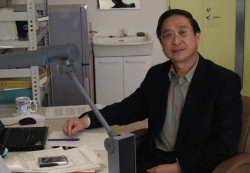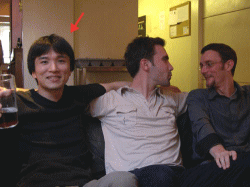
 |
I am from Center for Analysis and Prediction, China Seismological Bureau. I graduated from the Department of Geophysics, Peking University in July 1966. Then I entered the Geophysical Institute of Lanzhou, Academic Sinica to engage in the analysis of seismological data. In 1976, the great Tangshan earthquake occurred, and I moved to the Center for Analysis and Prediction, State Seismological Bureau (renamed as "China Seismological Bureau" now).
In July 1981, I entered Geophysical Institute, Faculty of Science, Tohoku
University, Japan as a research student. I did my research works under
the guidance of Professor Ziro Suzuki. During my stay in Geophysical Institute
of Tohoku University, I also participated in the seminars and other scientific
activities of the Research Center for Prediction of Earthquakes and Volcanic
Eruptions, and received the guidance of Professors Akio Takagi and Tomowo
Hirasawa, and other faculty members.
In December 1983, I finished my Ph.D. thesis entitled "Seismic Moment
Tensor Inversion of Earthquakes in and near the Tibetan Plateau and their
Tectonic Implications", and received Ph.D. degree from Tohoku University
in January 1984. In the research works of my doctoral thesis, I investigated
the seismic moment tensors of significant earthquakes in and near Tibetan
Plateau, discussed the tectonic process of the Tibetan Plateau and scaling
relations of source parameters. Based on the waveform modeling, I found
that there are many shallow earthquakes within Tibetan Plateau; most of
them are shallower than 10 km. This pattern of focus depth distribution
suggests there is a hot crust beneath Tibet Plateau.
After the studies for two and a half years in Japan, in January 1984 I returned to China, and continued my research works in the Center for Analysis and Prediction, China Seismological Bureau. With rapid development in digital seismological observations in China, the abundant observed data provide us a good opportunity to investigate deeply the earthquakes and interior of the Earth. While I investigated the seismic source parameter and source process of significant earthquakes, our group and I enlarged our research subjects by widely using digital seismic data, especially seismic waveform data. Our research subjects include the anisotropy of the crust and mantle, source parameters and its scaling law of small earthquakes, anelastic attenuation in the crust, ground strong motion, and so on. We also investigated the stress field and its temporary variation by shear wave splitting analysis based on the short period seismic waveform data obtained by near field seismic observations.
I have been continuing research collaboration with the researchers of
Tohoku University and other Japanese universities and institutes since
I returned from Japan in 1984. Being invited by these universities and
institutes and researchers, in recently years I have visited Research Center
for Prediction of Earthquakes and Volcanic Eruptions of Tohoku University,
Earthquake Research Institute of the University of Tokyo, Disaster Prevention
Research Institute of Kyoto University, Institute of Seismology and Volcanology
of Hokkaido University, National Research Institute for Earth Science and
Disaster Prevention, and so on.
It is my great honor this time to be invited as a visiting professor by Geodynamics Research Center, Ehime University to work with Professor Dapeng Zhao. This is my fourth time to visit the GRC Seismological Lab.. I understand well that the GRC Seismological Lab. is a very excellent research group; in recently years the group has completed a number of world famous studies. I hope I can do good research with Professor Dapeng Zhao during my stay in Matsuyama.



 |
昨年11月より本センターでみなさんとご一緒に研究をさせていただいている大藤です.私の専門は鉱物学で,特に走査型・透過型電子顕微鏡を用いた鉱物の微細組織・構造の観察や組成分析を
主な研究としてきました.そのほか,マクロレベルの記載的な鉱物学や岩石薄片中の鉱物鑑定,組織観察なども得意なところです.そもそも私が鉱物学をやっているのは,自然界がつくる色,かたち,構造の美しさに魅了され,それらを追いかけることの喜びを感じられるからです.
私は学部卒論以来,フランボイダルパイライトという顕微的な黄鉄鉱(FeS2)の木苺状の集合体に関する研究をしてきました.この直径0.1mm以下の小さな小さな球状の物質は,腐乱臭(硫化水素臭)がするような還元的な堆積物であれば,どこでも生成しています.しかし,このごく普遍的な鉱物が,どのような過程でどのような物理化学的条件において生成するのかという問題は,最初の発見から1世紀以上たった今でも謎に包まれています.その自己組織化作用を明らかにすることが私のこれまでのメイン研究テーマでした.
修士研究では,それまで球状であると思われていたフランボイダルパイライトが構造的には20面体充填構造をなすことを見出しました.このような多粒子の密な集合からなる20面体構造は自然界でも他に全く例がなく,物質化学的にも意義のある発見でした.また,博士研究では,その組織化過程が高過飽和度溶液中における黄鉄鉱核形成速度の増進,つまり一粒の実(核)をつくってそれを太らせることよりも,一度に小さな実をたくさんつくる(木苺をつくる)ことが不可欠であることが分かりました.実験的には,その環境がpH-Eh条件や硫黄や硫化物イオンによる触媒効果によって再現が可能なことを明らかにしました.また,フランボイダルパイライトの自己組織化作 用には結晶学的な操作は必要でなく,各結晶粒の表面エネルギーの最小化に起因する凝集作用が密接に関わっていることも分かりました.実はこのフランボイダルパイライトに類似の構造は,近年合成・研究の盛んなクラスターやナノ微粒子にも安定に認めれます.ですから,このようなミクロサイズの物質の構造,組織化過程を明らかにすることは,ナノ−ミクロ境界領域における粒子の物理的挙動を理解する上でも重要な手がかりになると期待されます.
本センターではこれまでの技術と経験を生かして,研究対象を地球深部の鉱物へ広げて,まだあまり明らかにされてはいない高圧鉱物(特にFe-S系鉱物)の微細構造などについても電顕鉱物学の立場から明らかにしたいと思います.最新の分析機器とたくさんの温かい人々に囲まれたこの環境で研究ができることを大変嬉しく思います.廊下などで会った際には気軽に声をかけてくださいね.
それでは今後ともよろしくお願いいたします.

← Back
Suihua Zheng
(外国人研究員(客員))
大藤 弘明
(研究機関研究員)

